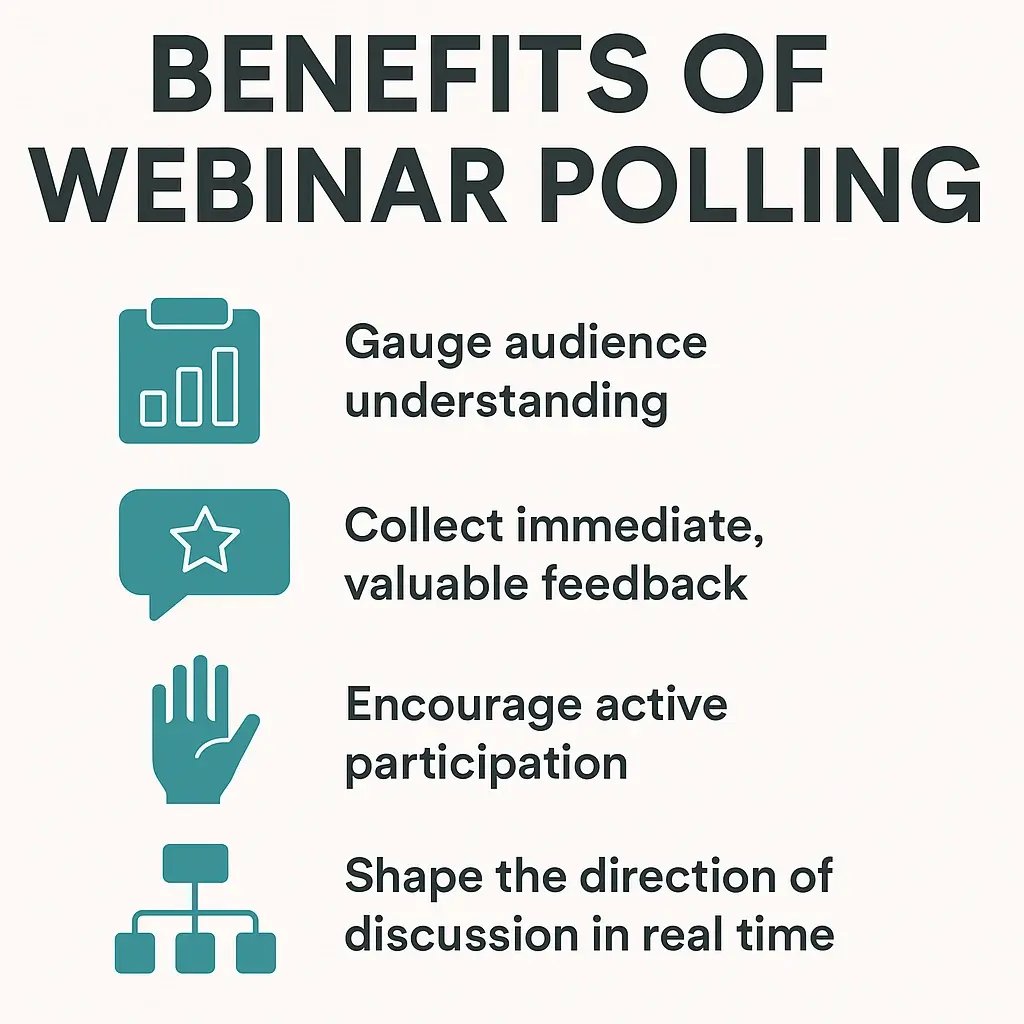9 Best Practices for Webinar Polling During Virtual Events
Webinar polling has become an essential feature for driving audience engagement and gathering real-time feedback during virtual events. Whether you're a developer integrating a polling tool into your platform, a business owner running product demos, or a health tech company hosting online education sessions, using webinar polling effectively can dramatically improve interactivity and participant satisfaction.
Webinar polling is a method of engaging virtual event attendees by asking live questions that gather feedback and boost participation. It helps hosts collect real-time insights, tailor content dynamically, and keep audiences actively involved, especially in remote-first industries like SaaS, healthcare, and edtech.
In this guide, we’ll explore the best practices for webinar polling, how to set up polls, the types of questions to ask, and how to use poll results to boost engagement. From choosing the right webinar poll questions to using the best webinar polling tools, this guide will help you create polls that truly resonate with your audience.
Table of contents
- Why webinar polling matters
- How to set up a poll during a webinar
- Best practices for webinar polling
- Effective webinar poll wuestions examples
- Wrap-up
Why webinar polling matters
Virtual events, while convenient, can easily become passive experiences where participants tune in but disengage after a few minutes. The lack of physical presence often makes it challenging for speakers to read the room or adapt based on audience reactions. This is where webinar polling plays a transformative role.
By allowing attendees to interact in real time, polling bridges the gap between presenter and participant. It provides a structured yet simple way for audiences to express their views, share their level of understanding, and contribute meaningfully to the session—without interrupting the flow of the event.
For hosts, polls serve as a diagnostic tool. You can quickly gauge comprehension, assess sentiment, or identify gaps in knowledge. For example, a health tech webinar might reveal that a significant portion of the audience is unfamiliar with a particular regulation, prompting the speaker to dive deeper into that topic.
Polling also creates a feedback loop. The data collected doesn’t just help you improve the current session—it becomes a treasure trove of insight for future events, marketing strategies, and product decisions.
Beyond functionality, webinar polling helps retain attention. Active participation keeps people focused and invested. When attendees know their input shapes the direction of the event, they’re more likely to stay engaged.
This is especially critical in remote-first industries such as SaaS, healthcare, and edtech, where digital touchpoints often replace in-person interactions. In these sectors, event polling is more than a nice-to-have feature—it’s a strategic asset for engagement, education, and user satisfaction.

How to set up a poll during a webinar
Knowing how to set up a poll correctly ensures you get the most value out of your session. Fortunately, most webinar polling tools are designed to make the process intuitive and quick.
In a typical webinar room—such as with Digital Samba—you simply click on the “Polls” tab, then select “Create new poll.” From there, write your question, add multiple answer choices, and click “Create.” You can either launch the poll immediately or schedule it to appear at a specific point during the session.
Here’s a general step-by-step breakdown for most platforms:
- Access the poll feature via your webinar control panel or host dashboard.
- Create your poll by entering a clear, concise question and providing answer options (e.g. multiple choice, yes/no, rating scales).
- Launch the poll live during the webinar when engagement is high, or pre-schedule it for key segments.
- Collect and monitor responses in real time—many tools offer live response dashboards.
- Share poll results with your audience immediately to foster transparency, or reserve them for post-event analysis.
For developers creating custom webinar tools or adding polling to existing apps, it’s worth choosing platforms with a robust video conferencing API and SDK. Digital Samba Embedded is a powerful option that supports real-time polling, response tracking, and flexible UI integration—all while maintaining data privacy and performance.
Best practices for webinar polling
Running a poll during a webinar may seem straightforward—but like any interactive tool, it’s only effective when used with purpose. Poorly worded questions, awkward timing, or technical issues can turn a useful feature into a distraction. On the other hand, a well-executed poll can completely change the tone of a virtual session, transforming passive viewers into active contributors.
Whether you're collecting market insights, validating assumptions, or simply breaking the ice, following webinar polling best practices ensures that your audience feels heard and your data is reliable. Below are some proven strategies to help you get the most from your webinar polling tools.
1. Keep questions clear and simple
When it comes to webinar polling, clarity beats cleverness every time. Your audience is there to learn, engage, and contribute—not to decipher cryptic or overly technical questions. A well-crafted poll question should be easy to read, easy to understand, and take no more than a few seconds to answer.
Avoid using industry-specific jargon, acronyms, or buzzwords that might not be familiar to everyone—especially if your audience spans different departments, job roles, or countries. For example, instead of asking “Do you rely on HL7 integrations in your current tech stack?”, a simpler version could be: “Do your digital tools connect easily with your patient records?” It’s the same idea, expressed in language everyone can understand.
This is particularly important for webinars with global or multilingual participants, where even fluent English speakers may miss the nuance of complex phrasing. Keeping language simple and accessible ensures inclusivity and encourages broader participation.
Additionally, short questions tend to perform better on mobile devices, where attendees may be tuning in on the go. Polls should be as frictionless as possible—one glance, one tap, done.
If you're unsure whether a question is too complicated, test it with a colleague outside your immediate team. If they hesitate before answering, it’s a sign you should simplify.
In summary: keep it short, keep it human, and keep it clear. Your response rates—and your audience—will thank you.
2. Ask questions that matter
Not all poll questions are created equal. To get meaningful engagement—and actionable insights—you need to ask questions that serve a clear purpose. Every poll should align with the overarching goals of your webinar, whether that’s collecting feedback, sparking conversation, or guiding attendees toward a specific next step.
Start by asking yourself:
- Why am I asking this question?
- What will I do with the answers?
- Does this question bring value to the session or the audience?
If you’re hosting a product-focused webinar, you might use polls to validate new features or assess market demand. For example, “Which of these upcoming features would be most useful to your team?” can help shape your development roadmap based on real-time feedback.
In health tech, where pain points can vary widely across institutions and roles, a poll like “What’s your biggest barrier to implementing virtual care?” allows you to tailor your message on the fly—perhaps by diving deeper into reimbursement, patient compliance, or tech integration depending on the majority response.
For internal or training webinars, asking something as simple as “Do you feel confident in applying what you’ve just learned?” not only provides insight into participant confidence but also signals areas where further clarification may be needed.
Meaningful poll questions also improve engagement by showing attendees that their input is valued and used. When you ask relevant, well-timed questions and adjust your delivery accordingly, you create a two-way dialogue—even in a one-to-many format.
Ultimately, the most effective poll questions are the ones that create impact—by shaping discussion, informing decisions, or guiding future communication. Don’t just fill your webinar with polls for the sake of interactivity. Ask questions that move the conversation forward.
3. Time your polls strategically
When it comes to polling, timing is everything. A well-placed poll can recapture fading attention, energise your audience, and give you the insight needed to steer the conversation. Conversely, a poorly timed poll—dropped into a dense explanation or in the middle of a demo—can feel disruptive and awkward.
Strategically timed polls help pace your webinar, providing natural breaks and breathing space for both attendees and presenters. Here's how to weave them seamlessly into your session:
- At the beginning: Kick things off with an icebreaker to warm up the room and humanise the experience. Questions like “Where are you joining from today?”, “What best describes your role?”, or “Have you attended one of our webinars before?” build rapport and give you a quick demographic snapshot of your audience.
- Midway through: This is your golden opportunity to re-engage. Attention typically dips 20–30 minutes in, so drop in a poll that checks comprehension, explores pain points, or allows the audience to shape the next section. For example: “Which topic would you like us to go deeper into next?” or “Is this pace working for you so far?”
- Before closing: Use a final poll to gather feedback, assess knowledge retention, or understand what your audience wants to see next. Questions like “How helpful was today’s session?” or “What topics would you like us to cover next time?” can inform your content roadmap and improve your future events.
Strategic polling not only maintains energy—it empowers your audience. It gives them a voice throughout the session and shows that you’re listening. This, in turn, boosts trust and strengthens engagement, especially in professional settings like product demos, stakeholder briefings, or virtual training events.
4. Display poll results thoughtfully
What you do after the poll is just as important as asking the right question. Displaying poll results in a thoughtful way can deepen trust, encourage continued engagement, and create a sense of community among attendees—if handled correctly.
When appropriate, showing results live reinforces that the audience's input matters. For light, inclusive questions—such as “Which tool do you use for virtual meetings?” or “What’s your preferred working style?”—sharing responses immediately can be energising and even spark spontaneous discussion. It validates attendees’ experiences and shows that they’re not alone in their views or challenges.
However, context is everything. In more sensitive environments—like healthcare, mental wellbeing, or internal company updates—some poll topics may touch on private or personal matters. Questions like “Have you ever delayed care due to cost?” or “Do you feel supported in your current role?” deserve a different treatment.
In these cases, consider:
-
Displaying results anonymously, showing percentages without identifying information
-
Withholding real-time results and instead sharing aggregate findings in a follow-up email or post-event report
-
Framing the poll clearly as confidential, so participants know their responses won’t be broadcast
It’s a balancing act. Transparency builds trust, especially when attendees see how their input shapes the conversation in real time. But privacy builds credibility—and in regulated industries like health tech or corporate training, erring on the side of discretion can make your audience feel safer and more willing to engage.
In short: display results in a way that supports your goals while respecting your audience. It's not just about data—it's about how you make people feel when they share it.
5. Test before you go live
Nothing disrupts the flow of a webinar faster than a poll that doesn’t work. Whether it fails to load, displays incorrectly, or doesn’t record responses, a broken poll can create confusion, interrupt momentum, and damage your audience’s trust in the session.
That’s why testing your polls in advance is non-negotiable. Before going live, set aside time to run through your polls as if you were an attendee. This includes checking:
- Formatting – Are your questions clear? Are the options laid out correctly, or do they break across lines awkwardly on smaller screens?
- Device compatibility – Test polls on various devices—desktop, tablet, and mobile—to ensure a consistent user experience.
- Browser support – Confirm polls behave as expected across common browsers like Chrome, Safari, Firefox, and Edge.
- Timing – Make sure polls trigger at the right moment in your presentation flow, especially if they're scheduled or linked to specific slide transitions.
If you're using third-party webinar polling tools or custom integrations via APIs, go one step further. Check that:
- Responses are correctly logged and attributed
- Poll results are displayed (or hidden) as intended
- Analytics and exports work as expected after the session
Running a rehearsal with a co-host or dummy attendee account can help simulate the live environment. It also gives you a chance to see how the polls look from the participant's perspective and spot any UX issues early.
These small, proactive steps can prevent embarrassing interruptions and help deliver a smooth, polished experience. In short: don’t let your first audience also be your first test group.
6. Ensure privacy and compliance
If you’re asking for feedback on personal or sensitive topics—such as patient experience or internal workflows—make sure your polling tool complies with data protection laws like GDPR or HIPAA (for U.S. audiences).
Let attendees know how responses will be used, anonymise data when appropriate, and avoid asking for personally identifiable information unless absolutely necessary.
Platforms like Digital Samba are fully GDPR-compliant and ideal for webinars in regulated industries such as health tech or finance.
7. Use polls to adapt content in real time
Polling isn’t just a way to collect feedback—it’s a powerful tool for making your webinar interactive, responsive, and participant-led. Used strategically, polls can guide the direction of your session and help you adapt content in real time, based on what your audience genuinely wants or needs.
Rather than sticking rigidly to a script, you can use polls as decision points throughout your presentation. For instance, asking something like “Which topic would you like to explore next?” and offering two or three relevant options allows attendees to shape the journey. If the majority selects Option B, pivot accordingly. You’ll be delivering content that resonates—because your audience asked for it.
This kind of live adaptability sends a clear message: “We’re listening.” It breaks the fourth wall of traditional presentations and turns a one-way lecture into a two-way dialogue. It’s particularly effective in training sessions, product demos, or educational webinars, where the relevance of content to the audience’s needs can make or break engagement.
Adapting in real time also builds trust. It shows flexibility, attentiveness, and professionalism. Even if you only make small adjustments—like spending more time on a particular pain point, or skipping over a well-understood concept—those changes signal to your audience that they’re not just watching a pre-recorded script.
Just be sure to plan for this flexibility. Build modular content blocks into your presentation, allowing you to smoothly switch gears without derailing your timing or structure. Having backup slides or alternate routes prepared in advance can make this seamless and stress-free.
In summary: when you use polls to shape the experience, you create a session that feels live, relevant, and collaborative—qualities that make virtual events far more memorable and effective.
8. Save and analyse poll results post-webinar
Polls don’t end when your session does. The data you collect can become a rich source of insight—but only if you take the time to analyse and apply it.
Rather than letting your poll results vanish into a forgotten dashboard, export them and integrate the findings into your broader workflows. If you're running a product webinar, poll data can inform your roadmap or feature prioritisation. If you're hosting a sales-focused session, it can help segment leads by interest, role, industry, or readiness to buy.
Post-webinar poll analysis can help you:
- Segment your audience based on preferences, behaviours, or challenges
- Spot patterns across regions, industries, or job functions
- Refine future content by identifying which topics resonated—or missed the mark
- Score and qualify leads for follow-up by identifying warm prospects through intent signals in their responses
In larger organisations, this data can be routed into your CRM, marketing automation, or analytics tools to support campaign targeting, account-based marketing, or customer success planning.
Even in smaller setups, reviewing poll responses in a spreadsheet can guide your next campaign or content idea. The key is to treat polling not as a one-off engagement tactic, but as an ongoing feedback loop that fuels better decisions.
9. Limit the number of polls you use
While webinar polling can boost engagement, it's important not to overdo it. Poll fatigue is real—and too many interruptions can start to feel mechanical or even annoying.
As a rule of thumb, aim for 2 to 4 polls in a 60-minute session:
- One at the start to warm up the room
- One in the middle to sustain engagement
- One at the end to gather feedback or guide follow-up
- An optional bonus if a topic shift or key decision point arises
If your session is highly interactive—such as a workshop or training—you may use more. But if it's content-heavy or time-sensitive, it's best to keep polling to a minimum so the flow isn’t disrupted.
Each poll should have a clear purpose. If a question doesn’t support your session’s goals or create value for attendees, it’s better left out—or converted into a follow-up survey after the event.
In short: don’t ask just because you can. Ask because the answer will guide your delivery, improve engagement, or enrich your post-webinar strategy.
Effective webinar poll question examples
Crafting the right poll question format is just as important as the content itself. The type of question you use should reflect the kind of response you want—quick confirmation, detailed preference, sentiment measurement, or open-ended feedback.
Here are four effective poll types commonly used in webinars, along with guidance on when and how to use them:
Yes/no questions
These are ideal when you want fast, binary input. They’re easy to answer, require minimal cognitive effort, and are excellent for gauging general sentiment or familiarity.
Example:
“Do you currently use video conferencing in your daily operations?”
Use this format when the goal is to get a clear consensus or when introducing a topic to establish a baseline.
Multiple choice
Multiple choice questions are useful when you need more nuanced feedback. They allow you to present predefined options, making it easier to segment responses or spot trends.
Example:
“Which features are most important in a telehealth solution?”
Options might include: secure video, EHR integration, appointment scheduling, mobile access.
This format is particularly effective for market research, prioritisation, or comparing preferences across your audience.
Rating scales
A rating scale helps quantify opinions and measure sentiment or confidence on a spectrum. Often structured from 1 to 5 or 1 to 10, these questions are great for capturing subjective data in a measurable format.
Example:
“Rate your confidence in your company’s data security measures (1–5)”
This approach is valuable for tracking perception over time or benchmarking satisfaction across events.
Open text (use sparingly)
Open-ended questions invite participants to write their own responses. While they provide rich qualitative insight, they take longer to answer and can slow the pace of the webinar.
Example:
“What topic should we cover next time?”
Reserve open text questions for small-group sessions, in-depth feedback at the end of a webinar, or when you’re specifically seeking inspiration or new ideas.
Wrap-up
Polling is an excellent way to boost engagement and conduct market research. If you follow our 9 best practices and put some time into your questions, you will be surprised by the results you can achieve. You will also avoid common pitfalls like asking intrusive or insensitive questions.
A fun and engaging poll that caters to your participants’ interests will help you create a unique and interesting webinar experience. Attendees want to feel like their time matters and that their opinions are important.
Nothing screams low effort like a poor-quality poll. If you master polling, you will always be able to provide high-quality and unique content.
With Digital Samba Embedded, you can embed video calls on your website, creating a unified experience for your attendees. Utilising our conference calling SDK, embedding the video room API becomes a seamless process, allowing you to offer rich interactive sessions right on your platform.
Digital Samba’s API and SDK enable you to integrate the video API effortlessly into your software products or websites. Whether for webinars, training sessions, or virtual conferences, you can customise your video environment to fit your brand and meet your unique needs. What sets Digital Samba apart is the assurance that our solutions are GDPR-compliant, EU-hosted, and end-to-end encrypted, offering you a secure and compliant way to engage your audience.
By embracing these technologies, you not only enrich the content of your webinars but also provide a seamless and immersive experience for your attendees. Discover how Digital Samba can be your partner in crafting memorable and engaging webinars. Contact our team today to learn more.
FAQs
Webinar polling allows hosts to ask live questions during a webinar, helping to engage participants and collect feedback in real time.
Yes, Digital Samba offer free webinar polling as part of our standard plans.
Typically, 2 to 4 polls is the ideal range. This keeps the session interactive without overwhelming your audience or disrupting the content flow.
Yes, most platforms allow you to set up and schedule polls in advance. This helps ensure a smoother experience and allows for better planning during your live event.
It depends on your settings. You can choose to display poll results live during the webinar or keep them private for analysis and follow-up after the session.
Export your poll data and use it to segment leads, inform future content, or support decision-making across marketing, product, or customer success teams.
Share this
You May Also Like
These Related Stories

Monetising Webinars: 5 Effective Strategies to Boost Your Revenue

Unlocking the Benefits and Opportunities of Virtual Events

